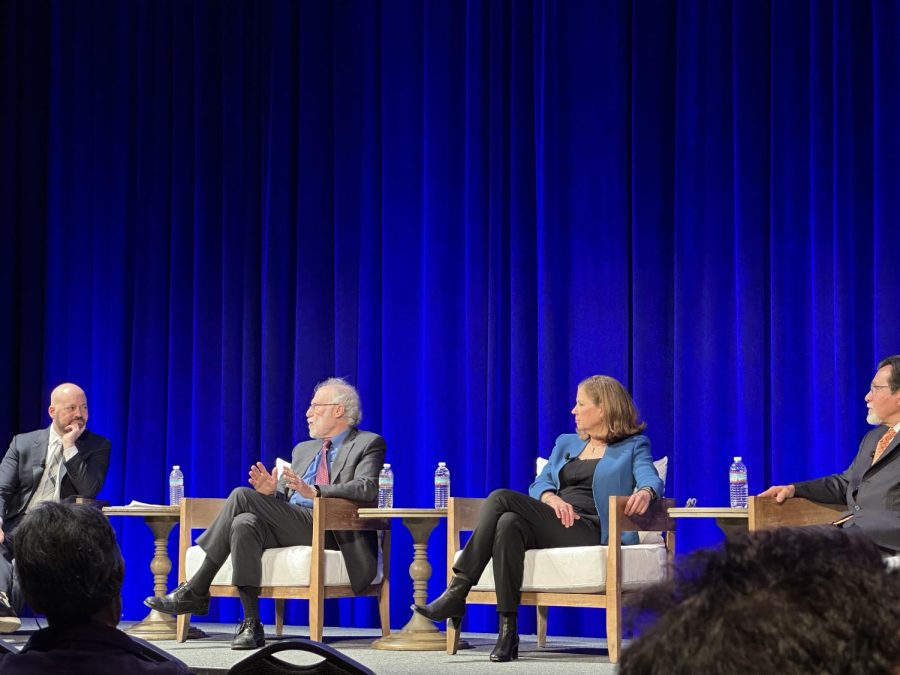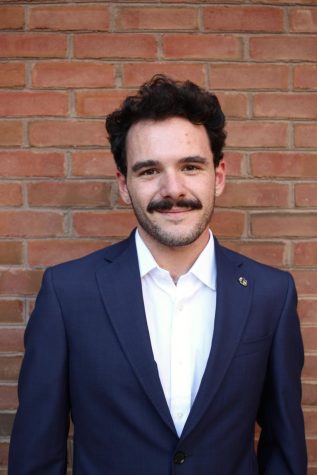Where We Go From Here: Perspectives on the Future of the Supreme Court
From left to right: Brian Fitzpatrick, Robert Bauer, Jan Crawford, Alberto Gonzales. Image credit: Ben Freed
December 1, 2022
The Vanderbilt Project on Unity and Democracy hosted a panel discussion on Tuesday Nov. 29, 2022, discussing the future of the United States Supreme Court as public trust in the institution reaches record lows.
The panel, moderated by Vanderbilt Law professor Brian Fitzpatrick, included Robert Bauer, professor of law at NYU Law, Alberto Gonzales, former Attorney General and Dean of the College of Law at Belmont University and Jan Crawford, Chief Legal Correspondent for CBS News. The conversation, which drew upon the diverse perspectives and experience of the panelists, attempted to create an understanding of the post-Roe Court while evaluating different strategies of popular reform amid growing dissatisfaction.
The panel began with discussion focused on the Court’s legitimacy after Dobbs v. Jackson, the case which overturned nearly 50 years of precedent set by the 1973 decision in Roe v. Wade that protected abortion rights at the federal level. The decision, which set a political firestorm over the summer, has stoked fears among progressives that an unprecedented level of conservative jurisprudence will guide the Court’s decisions for the foreseeable future.
“What we’re seeing now with the Court is certainly a reflection of the polarization that is affecting the politics of the country overall,” Bauer said while talking about the Court’s recent decisions. “It is never helpful or healthy for any one of our major institutions to suffer from public distrust.”
One of the factors the panelists highlighted as a contributing factor to the current level of mistrust includes the public’s level of education as to how Court renders its decisions. Here, the panelists––particularly Gonzales––made the point that individuals and the media have become more concerned with the results of cases rather than the substance of the arguments behind them.
“In the Dobbs case, people think the Supreme Court took away a woman’s right to choose. That is not what the decision does”, Gonzales said. “People need to study the opinions and really have an appreciation of what it does. I think too often people read headlines and don’t have a full appreciation of the decision.”
As it did with Dobbs, the Court releases its opinions within lengthy documents, where the arguments and summary include complex legal topics and language that some may find difficult to understand. Aside from written opinions, the Supreme Court largely operates outside the public eye, with only lengthy audio recordings of arguments being published for public listening. The result of this lack of transparency combined with the rules governing the appointment of justices to the Court has placed a growing importance on confirmation hearings as one of the few ways the public can familiarize themselves with the Court.
“The confirmation hearings have become circuses and sideshows that are not about any serious examination of judicial philosophy or constitutional interpretation. It has gotten caught up in the political process of winners and losers,” Crawford said. “So I think it is a mistake to place too much of the onus on the public. It is on us as journalists and those in the political process to present what the court is actually doing.”
The latter half of the discussion centered around possible solutions that could address the Court’s legitimacy problem. One idea that has gained popularity among progressives is the expansion of the Court, with some such as Sen. Elizabeth Warren calling for an addition of at least four seats to the bench. None of the panelists explicitly supported expanding the number of Justices on the Supreme Court, characterizing it as short term remediation for the blocking of hearings for Merrick Garland and the late-term Trump confirmation of Justice Amy Coney Barrett.
In addition, the panel discussed the potential for eighteen-year term limits for Court justices, with each president having the ability to select two justices for each term they are in office. Proponents of term limits argue that adding Justices to the bench on a routine basis would depoliticize the Court and remove pressure from confirmation hearings.
“The concentrated power [in the Supreme Court] is not embraced by our system of government. I think this is severely problematic,” Bauer said. “Jimmy Carter had zero Supreme Court appointments when he was president. Trump had 3. I think that it is a distortion of how we think about the democratic process in the context of the operations of the Court.”
While those in favor of judicial reform see promise in term limits, the feasibility of enacting the constitutional amendment necessary to implement such a change faces a challenging political landscape. Until then, the upcoming slate of Supreme Court decisions will be closely watched as their implications have the power to define the Court’s public legitimacy for the coming years.








